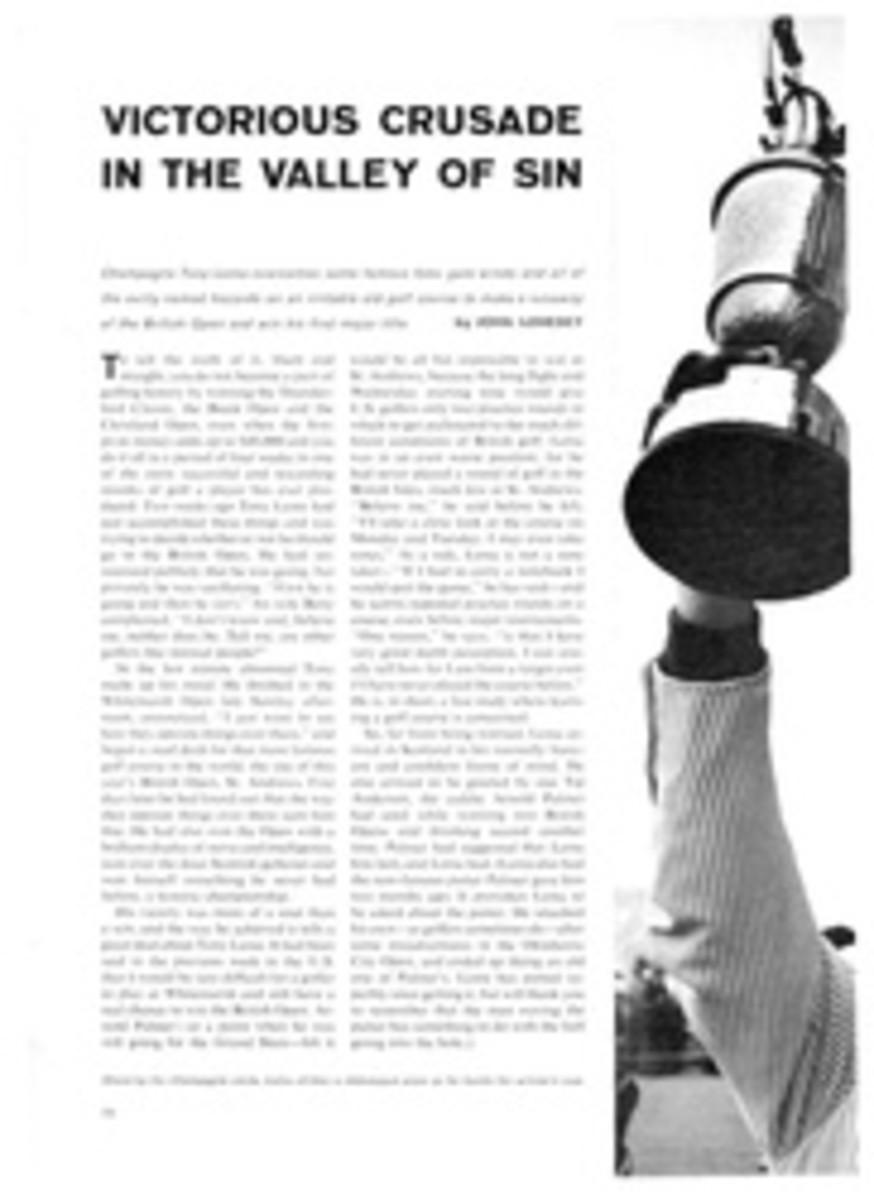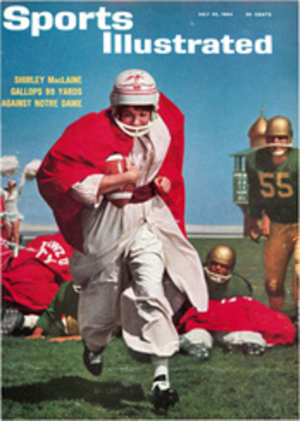
The Roast That Got the Judges off the Hook
The America's Cookout Championship (for men only), the final round of which is held early each year in Honolulu, is not as popular as, say, a Liston-Clay rematch, but nine arduous months of testing and tasting are involved in cutting down the field, and the finals are guaranteed to produce quite a bit more tension than one normally associates with a plate of spareribs. First prize is $10,000, and there are four second prizes, each a station wagon. The winners also have the satisfaction of knowing that their recipes will be borrowed and used by ambitious backyard chefs all over the nation, and the dishes the chefs meticulously concoct will be appraised by thousands of noncooking but critical backyard gourmets.
The competition, sponsored by the Kaiser aluminum-foil people for the past five years, is known as the World Series of Barbecue, and the cost to the Kaiser company is about $400,000. Some of this money goes into transporting food experts from the U.S. mainland to Hawaii to act as judges. Some of it is spent to transport the 25 finalists—selected from a total of 2,500 contestants—and their wives, who are invited, too. Some of it goes for brand-new grills and all the groceries and utensils the last round requires.
Miss Joan Crawford, the screen star, graciously threw out the first match at the 1964 World Series, lighting a cheery barbecue fire and galvanizing the 25 contestants into action. Under the hot Hawaiian sun they bent over grills and kitchen tables, mixing, chopping, basting and tasting. Slowly their efforts took on culinary form and flavor over the glowing coals. A short distance away, behind the closed doors of a secluded beachside cottage in the Ale Ale Kai Gardens of the Hawaiian Village, the judges looked at one another and wondered if a dish worthy of the $10,000 prize would be forthcoming.
As dishes were presented, admired and tasted, it became clear how far American contest cookery has come from the oldtime county fair, where the competition originated, and how subtle and complex a game it has become under the pressures of modern merchandising. The rules are basically simple: what is required is a dish that would normally be prepared on an outdoor barbecue grill, complete with motor-driven rotisserie, for a typical weekend party. How plain or fancy his dish will be is entirely up to the contestant. Last year a simple meat loaf won; this year the entries included a 12-pound stuffed ham prepared according to a recipe a page and a half long.
The judges, for their part, score each dish on three fundamental characteristics: Appetite Appeal, Practicality and Uniqueness. For the contestants, psychology plays almost as much part in the competition as the food itself. In their efforts to please, or possibly outwit, the judges, they have a wide range of stratagems. There is, first, the direct attack: cooking the best possible recipe in the best possible way. This demands the finest of ingredients, an artistic culinary instinct and a sure hand with charcoal—not the most easily manageable of cooking fires. The direct attack involves the greatest risks. There can be no compromise with perfection, no cover-up if the butter blackens or the hand that shakes the spices shakes too hard. But an imaginative dish conceived and executed along these lines has the impact of a no-hit game. If no bad luck mars the concoction in the final instant, it is a sure winner.
A second approach, chosen by many, is more in tune with our commercial era: aim for the sponsors' pocketbooks as well as the judges' tastebuds. A major cooking contest like this one involves corollary sponsors who produce some of the ingredients used—lamb as the meat, for instance, certain cereal products, spices, prepared sauces, fruits. Throw in as many of these as possible, the theory goes, and in the case of a deadlock the judges may lean toward the dish offering the greatest possibilities of commercial exploitation.
A third strategy is to overwhelm the judges with sheer display. Proponents of this school of cooking think in terms of flower garnishes, pyramids of fruit and impressive decorations made of shiny foil. If somewhere along the line something has been botched in the cooking, the Technicolor dazzle is expected to compensate for taste, or lack of it.
For the enthralled spectators, the drama this year began just a few minutes after noon when No. 17, the first dish to be submitted, was brought in by an excited runner escorted by a solicitous guard. Karl E. Sacks, a prominent figure in the wholesale plumbing business in Philadelphia, was its creator. He called it Gourmet Cookout Chicken. "For a starter," murmured one of the judges, cutting into the broiler halves stuffed with mushrooms, chopped pecans and cream, "this doesn't look too bad." On at least one judge's scorepad, Gourmet Cookout Chicken rated 15 out of a possible 20 points and would have rated higher except that the pecans overpowered the flavor of the stuffing and the meat.
The first winner of a station wagon was Arthur R. Ellis of Chula Vista, Calif. He took chicken breasts, shrimp, mushrooms and bacon, wrapped them together, marinated them in beer for an hour, then grilled them slowly on skewers over low coals. Served with curried rice, this combination—entitled Islander Chick 'N Shrimp—was judged a true barbecue delicacy.
One of the simplest dishes was offered by Leland C. Ellis (no relation to Arthur) of Dillon, Colo.: grilled chunks of liver wrapped in bacon and brushed with barbecue sauce. It was another winner. Scoring even higher was Dr. Jack C. Fisher, a Minneapolis physician, with Paradise Lamb en Brochette. And when Raymond M. Freeman, who is in the English department at Illinois Wesleyan University, weighed in with his Hawaiian Glazed Spareribs, the fourth station wagon was disposed of.
No one, however, had come up with a dish worth $10,000, and tension mounted as the afternoon wore on. The 12-pound stuffed ham had come and gone, ruled out on the grounds of impracticality and the oversweetness of its sauce. An Aztec Silver-plated Pot Roast was deemed a dish that should more properly have been prepared on a kitchen stove. Ham Rolls Hawaiian, which included a potpourri of ingredients ranging from horseradish and sauerkraut to crushed pineapples and cranberries, fell a victim to its own clashing mixtures. Worried frowns creased the judicial brows. There were only seven dishes left to be tasted—and then appeared Luau Pork Ambrosia.
From the moment it was brought in, this barbecued pork roast dominated the scene. Gaynor Maddox, the white-haired food expert of the NEA Syndicate, silently stood, carving tools in hand, savoring the aroma. The remaining judges—Isabel DuBois of the Chicago Daily News, Mrs. Florence LaGanke of the Cleveland Press, Phyllis Tamor of The Cincinnati Enquirer and I (representing SPORTS ILLUSTRATED)—were similarly captivated. Marinated in apricots, honey, lemon juice, soy sauce, garlic, onion, ginger ale, ginger and pepper, and roasted on a spit over low coals, Luau Pork Ambrosia, garnished with whole apricots sprinkled with shaved coconut, was a culinary masterpiece. All ingredients were blended in perfect harmony, with the charcoal fire adding a final touch of light, sweet smoke.
Who was its creator? On the following Monday morning, judges and spectators found out when Dr. Gail S. Erbeck, a dentist from Mason, Ohio, stood poised to snap a picture of the winner—and heard his own name called. Raised on a farm, Dr. Erbeck had been cooking outdoors since he was in high school but had never entered a contest before. When it was learned that he raised his own beef on the farm he still owned outside of town, he was asked why he had not entered a beef recipe instead of pork.
"I felt I had gone as far as I could with beef," said Dr. Erbeck, whose penchant for delicate experiments with viands would doubtless have pleased Auguste Escoffier." But pork was a new challenge. Considering the strength of the competition, I guess it must have turned out pretty well. Now somebody will have to take my picture."

